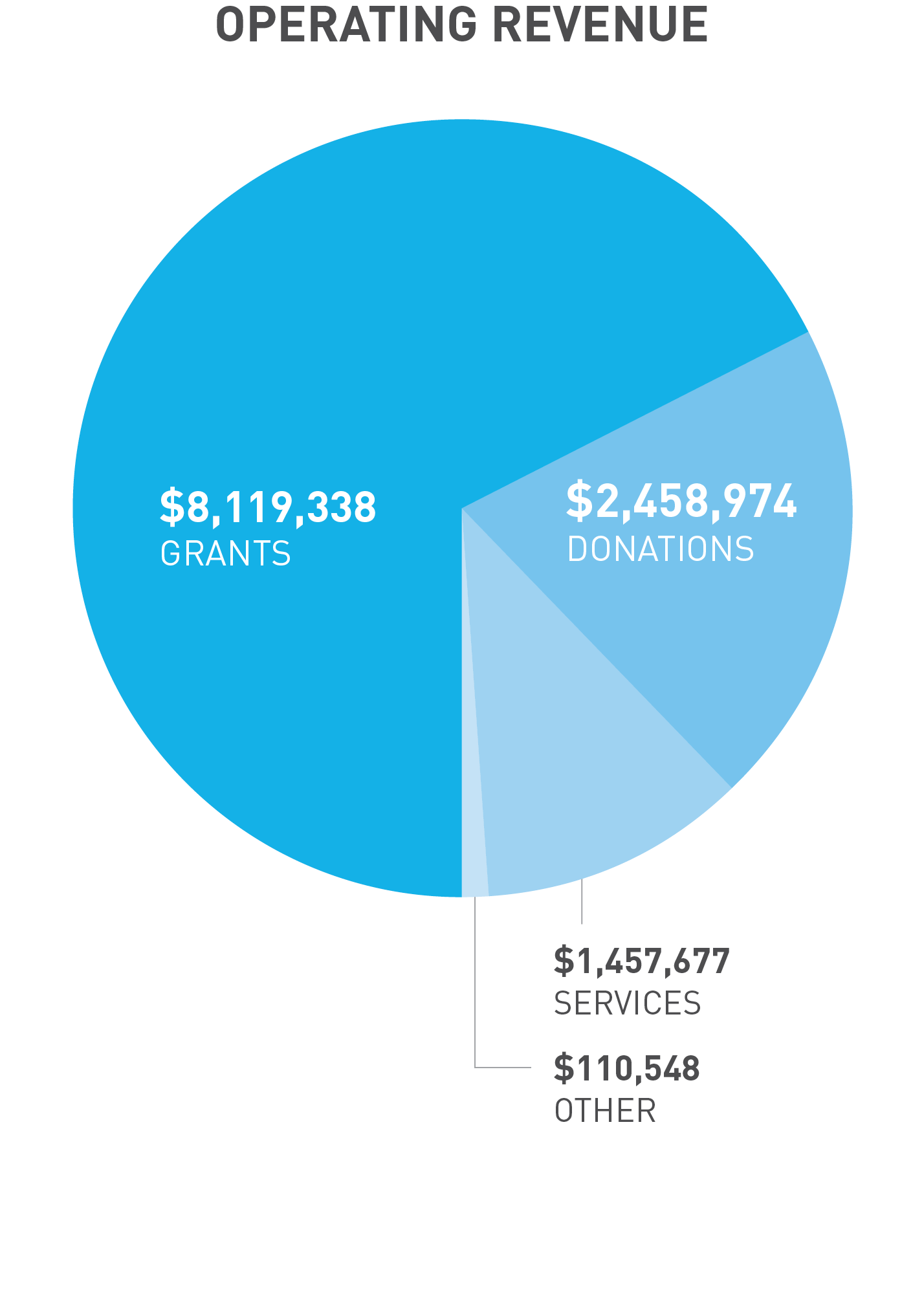
From its sunlit surface to its darkest depths, the ocean teems with life — and potential.
Each year, Bigelow Laboratory scientists search the globe for new ways to unlock all the ocean has to offer. With your support, we’re discovering how the ocean works, how we can best care for it, and how it can be used to improve life for all on the planet.
Ocean science shows us that small things can have a truly incredible impact.
Most of the marine life that forms the foundation of global ocean health is microscopic, but its influence on the planet is great.
As I reflect on the last year, I feel like the same could be said about Bigelow Laboratory. Our creative, interdisciplinary approach requires us to remain modest in size, but it allows us to have disproportionate impact.
This simply wouldn’t be possible without the help of our donors. Their generosity supports our discoveries, powers our solutions, and enables us to inspire the next generation of ocean leaders.
I hope you enjoy this glimpse at the impact of their investment in the future of our oceans.


Deborah Bronk, PhD, President and CEO

Photo: Christoph Aeppli


Untangling the effects of natural climate, seasonal cycles, and climate change in the ocean is a major challenge. Our scientists conduct time series studies around the planet that create invaluable, long-term data sets. These studies have a unique power to illuminate how our oceans work, while providing the consistency and longevity needed to understand how they are changing.
Our researchers are experts in cutting-edge technologies that allow us to examine large sets of genetic information. This year, we revealed the staggering degree of biological diversity in a single drop of seawater. By taking a big data approach to individual microbial genomes, this research is providing insights into the ecology, evolution, and biotechnology potential of the global microbiome.
Deep-sea microbes thrive in, and even below, the deepest parts of the ocean. This year, we studied life in these extreme environments by examining the genetic information of microbes in hot, oxygen-free fluids that flow through the Earth’s crust. Our research revealed how one group of unusual organisms provides clues to the evolution of life on Earth.
Photo: Peter Countway


Just as in the ocean, harmful algae and bacteria can impact freshwater ecosystems and the people who live near them. Our researchers are leveraging their expertise in marine algal toxins to develop technologies that can be used in lakes. Their molecular approaches will improve efforts to monitor for harmful algae and bacteria — preserving water quality and protecting people’s health.
Methane is a potent greenhouse gas, and cattle are its largest human-caused source. Our scientists are working to develop dietary supplements that use Maine seaweeds to reduce methane emission by cattle, and potentially even improve their health. This could have a major impact on global greenhouse gas emissions while supporting dairy and seaweed farmers in the Northeast and beyond.
Shellfish like oysters and mussels have long been overlooked in biomedical labs, but our studies are showing the potential of using them as a platform for research — from pharmaceutical development to bone regeneration. This work is highlighting the potential of these shellfish to revolutionize human health research and offer unique ways to develop new solutions.
Photo: Christin Khan, NOAA, NEFSC


The Gulf of Maine’s surface is warming rapidly, and new research has revealed that some of its depths are warming even more dramatically. We are untangling how this is impacting life in the Gulf — from tiny crustaceans to the endangered right whales that feed on them. What we are learning about these relationships is helping adapt strategies to protect right whales and the region’s economy.
As the ocean warms, subtropical waters are becoming more favorable for corals. Our scientists discovered this year that the number of young corals on tropical reefs has declined by 85 percent — and doubled on subtropical reefs — during the last four decades. These new reefs may provide refuge for other species challenged by climate change and new opportunities to protect these fledgling ecosystems.
The Greenland Sea is being profoundly altered by global climate change. This year, we discovered that algae flourish beneath its sea ice and fuel the ecosystem. Our scientists deployed new technology that uncovered how the phytoplankton community changes throughout the year. This new understanding improves the ability to predict and prepare for the future of this important region.
Photo: José Alejandro Alvarez


Grazing fish keep coral reefs healthy by preventing seaweeds from taking over. A new study this year showed that the diversity of fish that graze on reefs can have as much of an effect as the amount of fish that do so. Our findings about the powerful influence of biodiversity on Caribbean coral reefs can help fishery managers support the diverse communities that keep reefs healthy.
Understanding the timing of plant and animal life cycle events is essential to anticipating and managing the effects of climate change. However, little is known about seasonal events in the Gulf of Maine and other ocean ecosystems. New research this year synthesized what scientists know and identified what research is needed to protect the Gulf of Maine and its coastal economy.
Though there are a record amount of lobster larvae being born in the Gulf of Maine, the number that survive their first month is shrinking. Our scientists are searching for the root of this disconnect and for clues as to why juvenile populations have decreased. What they find will help manage this crucial fishery and explain important food web linkages in the Gulf of Maine.

Bigelow Laboratory is an independent, nonprofit institute. Our impact is only possible with the help of a generous community. They share our passion for the ocean and our optimism about its boundless potential. They advise us, inspire us, and provide the philanthropic support that powers our work.
We are immensely grateful to these Council members, whose exceptional generosity has advanced our mission during the last year.
- Anonymous (8)
- Mariann and Jonathan Bigelow
- Stewart and Nancy Bither
- Pete and Ann Bixler
- Blue Dot Foundation
- Joe and Sheri Boulos
- Louise Bowditch*
- Bill and Barbara Burgess
- Donna Lee Cheney*
- Consigli Construction Co., Inc.
- Holly and Rory Cowan
- Andrew and Kathryn Davis
- The Shelby Cullom Davis Charitable Fund
- Chip and Nan Davison
- First National Bank
- Marion T. Flores
- Mr. and Mrs. Christopher Flower*
- Jon and Sue Greenlee
- H.M. Payson
- Randall and Mary Hack
- Mr. and Mrs. William D. Haney
- Charles P. Harriman
- Ina and Lewis Heafitz
- Robert and Margery Healing*
- Horace^ and Alison Hildreth
- Mark and Marion Howard
- James L. Jaeger
- Randall and Kimberly Jeffery
- Sarah Jeffords
- Russell and Mary Jeppesen
- Jane C. MacElree
- Mr. and Mrs. Will Mackenzie
- Stephen L. Malcom
- Elizabeth and Arthur Martinez
- Dyke Messler and Rickey Celentano
- Richard and Eleanor Morrell
- The Muir Family
- David Newbower
- Helen Norton
- Penny C. Paquette
- Herbert and Harriet Paris
- JoAnne Platt
- Gerry Plumley
- Abby and Larry Pratt
- Dana and Martha Robes
- Louis and Honor Sage*
- Kristin and Michael Sant
- Schacknow Family Foundation, Inc.
- Chet and Evelyn Shuman
- Estate of Wickham Skinner*
- Lindy Snider
- The Snider Foundation
- Mary M. Spencer
- Barbara Sweet
- Paul and Chandler Tagliabue
- Susie and Marty Tendler
- Anna Marie and John E. Thron
- Peter P. Twining
- Estelle Weedon
- The White Family
- Mr. and Mrs. William F. Whitman
- David Wilde
- Lisa Wilde
- Richard Wilde^
- Wendy Wolf and Mary Neal*
- Philip Yasinski and Janet Reingold*
Deceased donors are noted with a caret (^). Those who have named Bigelow Laboratory in their estate plans are noted with an asterisk (*).




These charts pertain to our 2019 fiscal year – July 1, 2018 to June 30, 2019. You can view our audited financial report at bigelow.org/financials.



